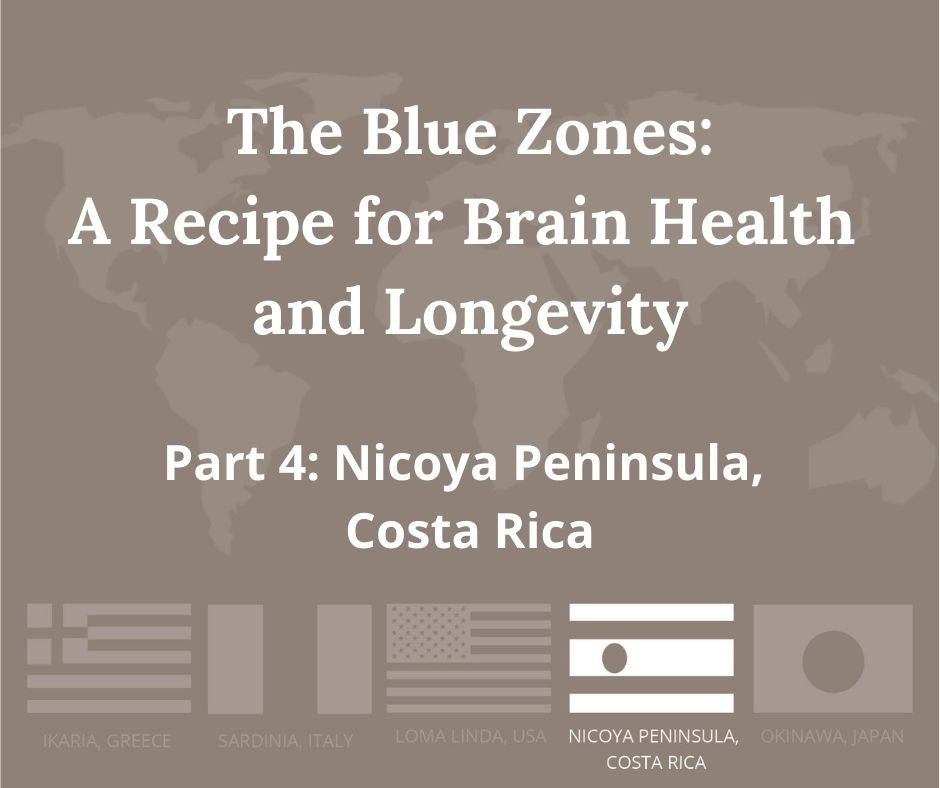The Blue Zones: A Recipe for Brain Health and Longevity, Part 4: Nicoya Peninsula, Costa Rica

The Blue Zone regions share common lifestyle factors that add up to the perfect recipe for longevity and health, including brain health. In part 4 of this article series, we travel to the Blue Zone region of Nicoya Peninsula, Costa Rica, to learn how they incorporate diet, stress reduction, sense of purpose and connection, and physical activity into their daily lives. We also take a look at how we all can enjoy longer, happier lives (and better brain health) by taking cues from their lifestyle and applying it to our own.
Nicoya Peninsula, Costa Rica

The Nicoya Peninsula lies on the Pacific coast of Costa Rica in Central America. This largely mountainous region is covered in tropical forests. This 80-mile peninsula is home to one of the longest-lived populations in the world, with the second-highest concentration of male centenarians. Here, compared to the rest of Costa Rica, there are more hours of sunlight on average during the year, it is hotter and drier, and the water is sourced from the peninsula’s limestone bedrock.
Diet
The plant rich Nicoyan diet is plentiful in squash, beans, and homemade corn tortillas. These foods are abundant in Central American agriculture, so are produced locally. Local tropical fruits abundant in antioxidants, including vitamin C, grow in backyard gardens. Here, oranges and bell peppers can be a great source of vitamin C. Home-grown corn is dried, soaked in water with lime, and ground to make tortillas that are served with beans and squash. This combo is rich in calcium, protein, vitamin B6, and complex carbohydrates – a cardiovascular powerhouse.
The water here is very hard, meaning it contains more calcium and magnesium than other parts of the country, and paired with vitamin D made from time in the sun, contributes to stronger bones, and lower rates of heart disease and cancer.
Stress Management
The Nicoyan lifestyle has kept them relatively free of stress. Despite being poor by modern standards, they tend to believe that a higher power (God) is looking out for them. Traditional living typically means there is no entertainment from television. Instead Nicoyans mindfully enjoy simple pleasures, like socializing or enjoying an orange in the shade on a hot day. They get to bed early and sleep for seven to nine hours each night. As one woman put it in Buettner’s book, “We stay busy enough to keep the Devil away, but not so much that we get stressed.”1
Sense of Purpose and Connection
One common trait of the Nicoyan residents over 90 is that they feel a strong sense of service to others. Nicoyans are devoted to their family, and many generations tend to live together. For example, in his book, The Blue Zones, Dan Buettner tells the story of a 101-year-old man who still takes a bus to the market each week and cooks the same soup for his family. He takes pride and feels purposeful by providing this meal for his family each week. This sense of purpose is called plan de vida and appears to be an important part of why Nicoyans achieve longevity.1
Physical Activity
Nicoyans tend to find joy in the physical nature of their work and everyday chores. Traditionally, the men are farmers, waking early to head into the fields for an active day of work. Visiting neighbors in some areas means a 2.5 hour walk followed by socialization over a meal. Similarly to other Blue Zones, the environment and lifestyle encourage moderate, regular physical activity.
Take a Cue from Nicoyans
The home-grown Nicoyan diet is plentiful in locally grown and nutrient rich plant foods, like squash, corn, beans and fruit. With plenty of sunshine and uniquely mineral-rich water, their nutrient intake is highly supportive of strong cardiovascular, bone, and brain health. Having a plan de vida, regular physical activity, and low perceived stress are fundamental aspects of Nicoyan culture that provide for longevity with physical and cognitive health.
Read parts 1-3 of this series, where we travel to Ikaria, Greece, Sardinia, Italy and Loma Linda, USA.
Reference
1. Buettner, D. The Blue Zones: 9 lessons for living longer from the people who’ve lived the longest. (National Geographic Society, 2012).


